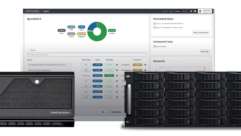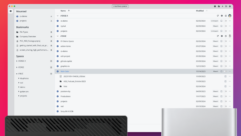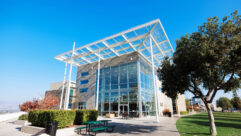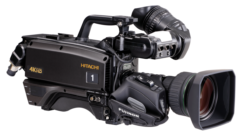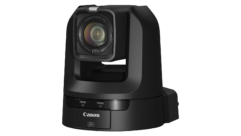Documentary filmmakers have long agreed that the more inconspicuous the camera, the more “truth” it can capture. The proliferation of compact, highly mobile video cameras during the past 20 years has proven this to be true, but many of today’s documentarians not only want a camera that won’t intimidate interviewees, they also want a camera that can capture imagery that’s more cinematic. The filmmakers behind two of this year’s Oscar-nominated documentaries achieved both goals by using digital SLR cameras from Canon U.S.A., Inc., a leader in digital imaging solutions. Directors Danfung Dennis (Hell and Back Again) and Lucy Walker (The Tsunami and the Cherry Blossom) recently discussed the advantages of their Canon digital SLR cameras during interviews at the International Documentary Association’s Los Angeles DocuDay event. Each documentary took advantage of a different EOS DSLR and series of EF lenses to uniquely capture their particular stories. Dennis’ camera of choice was the EOS 5D Mark II, while Walker and her director of photography Aaron Phillips used an EOS 7D DSLR.
Hell and Back Again tells the story of a U.S. Marine Corps sergeant’s battle with post-traumatic stress disorder after his return from Afghanistan. The film combines combat footage shot by Dennis with intimate scenes of the soldier’s physical and emotional difficulties as he tries to readjust to everyday married life as a civilian in North Carolina. Prior to shooting the film, Dennis spent several years as a photojournalist covering both Iraq and Afghanistan with Canon DSLR cameras. An early adopter of the HD capabilities of the EOS 5D Mark II, Dennis built a stabilization rig for the camera that enabled him to shoot run-and-gun video while embedded with Echo Company 28 of the 2nd Marine Division in Southern Afghanistan.
“I have always been interested in how I could advance documentary cinematography so that it was closer to the methods and look of both still-photojournalism and narrative cinematography,” Dennis explained. “I was deeply moved by past war photographers, especially those from the Vietnam era. I wanted to borrow from the syntax of photojournalism, and then mold and shape it with cinematic HD to convey the emotional power of still images to give audiences a very direct, immersive feeling of what it’s like to go to war and then come home from it. Canon’s EOS 5D Mark II allowed me to do that, with extremely high-quality lenses and a small single-person set-up that enabled me to get into various situations ranging from combat zones to the home of an injured soldier. This type of visual medium helped me get into that person’s mind, and was very different from a traditional documentary look and feel.”
Technology and Trust
Upon returning to the U.S., Dennis rebuilt his EOS 5D Mark II camera-stabilization rig to be even smaller and less intrusive for capturing cinema vérité footage of the everyday lives of the sergeant and his wife. Shooting extensively in interior locations, Dennis had special praise for the low-light capabilities of the Canon 5D Mark II’s 21.1-megapixel 36mm x 24 mm full-frame Canon CMOS sensor, and for the Canon EF series lenses he used.
“The 5D Mark II’s sensor is incredible, I was pushing the limits of what’s possible with its low-light capabilities,” Dennis stated. “You can shoot at extremely high ISOs and still have a relatively clean image. I also used really nice Canon lenses, an EF 35mm f/1.4 and an EF 50mm f/1.2. Those L Series lenses allowed me to open it all the way up to f/1.2 in extreme low-light, push the ISOs quite high, and still get this incredible image without having to use any external lights. They gave me a shallow depth of field for conveying a lot of the emotions of the central character. In Afghanistan I primarily used an EF 24-70mm f/2.8, which gave me the diversity necessary to get wide and tight shots, without having to fumble and change lenses when there is a lot of dust and action going on. The EOS 5D Mark II and its EF lenses allowed me to work as one person with one rig and shoot an entire film.”
Equipment aside, Dennis hastened to mention another essential element of his documentary technique that goes beyond using a small camera with no intimidating movie lights. That element is trust.
“I think it’s really also about having that level of trust with your subjects, where they are willing to open up to you and let you capture something that is very personal and raw,” he noted.
Visual Haiku
Trust was also key to director Lucy Walker and DP Aaron Phillips’ interviews of Japanese earthquake and flood survivors in The Tsunami and the Cherry Blossom. Touring areas devastated by the 2011 Tohoku earthquake by car and on foot, Walker, Phillips, and their driver/translator carried their Canon EOS 7D cameras and minimal gear in backpacks, and were always careful to tell their interview subjects that they were filming video footage and not just taking still pictures.
“It was important for people to understand that we were shooting video, because you want them to be ‘on-board’ with what we were doing,” Walker said. “And even though they knew we were filming, the compact size of the Canon 7D and its familiar stills-camera appearance helped avoid any ‘intimidation’ factor. They felt comfortable, and you always want the scene to be about the people you’re filming – candid, honest, and emotional – and not about the crew and the equipment. The EOS 7D was absolutely super for us and we never really considered an alternative.”
“The Canon EOS 7D was liberating,” Phillips agreed. “I don’t think people would have been as receptive to us if we had a larger, traditional-format documentary camera. I think we would have been booted from many locations if we had a crew with boom poles and lights. The EOS 7D made us much more ‘human’ and sensitive to the situation.”
Walker and Philips shot interviews with survivors in the areas hardest hit by the disaster, juxtaposing that footage – and news video of the tsunami – with scenes showing the beginning of cherry blossom season, a cherished annual tradition in Japan. As the film’s website notes, The Tsunami and the Cherry Blossom is “a stunning visual haiku about the ephemeral nature of life and the healing power of Japan’s most beloved flower.”
A Cinematic Look
Walker and Phillips found that the 18-megapixel APS-C-size CMOS sensor in the Canon EOS 7D digital SLR camera was particularly well-suited not only for photographing the beauty of nature in bright outdoor settings, but also for shooting intimate, emotional indoor interviews in subdued lighting. “To have the option to shoot with no light and still get a gorgeous image was important,” Phillips related.
Lenses used for filming The Tsunami and the Cherry Blossom included a combination of Canon EF series models. “We used all Canon lenses, including Canon L-Series zooms: the EF 16-35mm f/2.8, the 24-70mm f/2.8, and the 70-200mm f/2.8,” he said. “We also used a Canon Extender EF 2x and did a little work with 24mm and 45mm Canon tilt-shift lenses.”
Crafting beautiful images for a documentary is as appropriate as it is for any other kind of film, Walker believes. There’s no reason why a documentary has to have a traditional “documentary” look. “People often think of documentaries as being poorly shot and low quality, but I like to think of documentaries as being potentially very beautiful,” Walker explained. “Just because it’s depicting real life doesn’t mean that it’s ugly. Aaron is the kind of cinematographer who can bring artistry to spontaneity, even when I am demanding that we move fast. I believe you should be able to deliver results that stand up to a big-screen cinematic blow-up and look absolutely stunning.”
Both filmmakers believe that this is a golden age for documentary production, due not only to the sophistication of cameras such as the Canon EOS 7D digital SLR, but also due to the elimination of the cost of film and processing made possible by digital recording and editing.
“The decreased cost is a huge advantage,” Walker stated. “You have the flexibility to shoot, experiment, and explore. We were translating Japanese as we went, which slowed the interviews, but we didn’t have to cut. This does make it easy to shoot too much content and get into trouble in post, but we didn’t. We had 46 hours of footage, which would have been totally unaffordable in film, but for us it was the absolute right amount to shoot, and a fabulous freedom. Now it is easier than ever to sculpt stories from scratch, and I credit the new digital tools of non-linear editing and affordable, cinematic cameras such as the Canon EOS 7D digital SLR as the reason why it’s such an exciting time to be a documentary filmmaker.”
###


